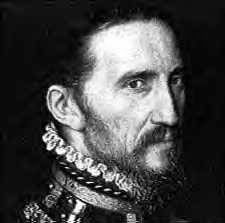| Francisco Vázquez de Coronado  Born: c. 1510 Born: c. 1510
Birthplace: Salamanca, Spain
Died: 22-Sep-1554
Location of death: Mexico City, Mexico
Cause of death: unspecified
Remains: Buried, Santo Domingo Church, Mexico City, Mexico
Gender: Male
Religion: Roman Catholic
Race or Ethnicity: Hispanic
Occupation: Explorer Nationality: Spain
Executive summary: Discovered the Grand Canyon Spanish explorer of the southwestern part of the United States of America. He accompanied Antonio de Mendoza to New Spain in 1535; by a brilliant marriage, became a leading grandee, and in 1539 was appointed governor of the province of New Galicia. The report presented by Fray Marcos de Niza concerning the "Seven cities of Cibola" (now identified almost certainly with the Zuņi pueblos of New Mexico) aroused great interest in Mexico; Melchior Diaz was sent late in 1539 to retrace Fray Marcos's route and report on his story; and an expedition under Coronado left Compostela for the "Seven Cities" in February 1540. This expedition consisted of a provision train and droves of livestock; several hundred friendly Indians, Spanish footmen, and more than 250 horsemen. Coronado, with a part of this force, captured the "Seven Cities." The fabled wealth, however, was not there. In the autumn (1540) Coronado was joined by the rest of his army. Meanwhile exploring parties were sent out: Tusayan, the Hopi or Moki (Moqui) country of northeastern Arizona, was visited; Garcia Lopez de Cardenas discovered and described the Grand Canyon of the Colorado; and expeditions were sent along the Rio Grande, where the army wintered. The Indians revolted but were put down. The army, reinspirited by the tales of a plains-Indian slave about vast herds of bison on the plains, and about an Eldorado called "Quivira" far to the northeast, started to there in April 1541, and, with a few horsemen, penetrated at least to what is now central Kansas. Here Coronado found a few permanent settlements of Indians; in October he was again on the Rio Grande; and in the spring of 1542 he led his followers home. Thereafter he practically disappears from history. The first description of the bison and the prairie plains, the first trustworthy account of the Zuņi pueblos, the discovery of the Grand Canyon, a vast increase of the nominal dominion of Spain and Christianity (the priests did not return from Cibola), and a notable addition to geographical knowledge, which, however, was long forgotten, were the results of this expedition; which is, besides, for its duration and the vast distance covered, over mountains, desert and plains, one of the most remarkable expeditions in the history of American discovery. In connection with it, in 1540, Hernando de Alarcon ascended the Gulf of California to its head and the Colorado river for a long distance above its mouth.
Do you know something we don't?
Submit a correction or make a comment about this profile
Copyright ©2019 Soylent Communications
|